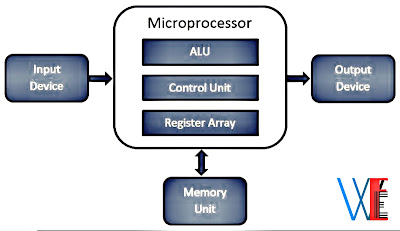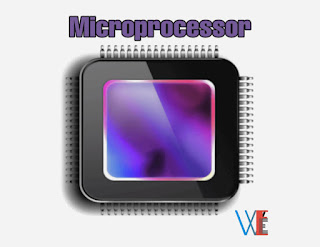What is Microprocessor? | Block Diagram of Microprocessor | Application of Microprocessor
Basic Detail Of Microprocessor
The microprocessor is a semiconductor device consisting of electronic logic circuits manufactured by using either a large scale(LSI) or very large scale integration(VLSI) technique.
The microprocessor is capable of performing computing functions and making decisions
to change the sequence of program execution.
to change the sequence of program execution.
In large computers, the central processing
unit(CPU) performs these computing functions and it is implemented on one or more
circuit boards.
unit(CPU) performs these computing functions and it is implemented on one or more
circuit boards.
The microprocessor is in many ways similar to the CPU, however, the microprocessor
includes all the logic circuitry(including the control unit)on one chip.
includes all the logic circuitry(including the control unit)on one chip.
The microprocessor consists of the following
three segments which is shown in below diagram.
three segments which is shown in below diagram.
 |
| Block Diagram of Microprocessor |
1.Arithmetical Logical Unit(ALU)
In this area of the microprocessor, computing functions are performed on data.
The ALU performs arithmetic operations such as addition and subtraction, and logical operations such as AND, OR and exclusive OR.
2. Register Unit
This area of the microprocessor consists of various registers.
The registers are used primarily to store data temporarily during the execution of a program.
Some of the registers are accessible to the user through instructions.
3. Control Unit
The control unit provides the necessary timing and control signals to all the operations in the microcomputer.
It controls the-flow of data between the microprocessor and peripherals including memory.
In short a microprocessor performs the following functions:
✓ Communicates with all peripherals such that memory and I/O using system.
✓ Controls timing of information flow.
✓ Performs the computing tasks specified in a programme.
Characteristics of Microprocessor
In nearly every type of design, with any complexity at all, microprocessors have potential for drastically reducing component count and shortening design time.
In fact a microprocessor is considered to represent long awaited next generation of digital building blocks, and that microprocessor will provide the best single approach to the system level digital integrated circuit.
Some of the characteristics of a microprocessor are mentioned below:
✓ It handles shorter words than other computers, usually from 4 to as many as 16 bits.
✓ It consists of integrated circuits from 1 to 30 in number.
✓ It contains arithmetical logical unit(ALU), registers, control, Random access Memory(RAM), data buses and read only memory(ROM) with programmes.
The important features of the microprocessors are listed below:
✓ Low cost
✓ Small size
✓ Low power consumption
✓ Versatile
The versatility of a microprocessor results from it's stored programme mode
of operation.
of operation.
✓ Extremely reliable
Probably the term' micro in the name of the device can be contributed to its low cost, small size and low power consumption.
The processing capability of a microprocessor should not, however, be underestimated.
Currently available 32-bit microprocessors have a processing power similar to that of the mainframe computer of a few years ago.
Even the early 8-bit microprocessors are powerful enough to perform several applications.
Application of Microprocessors in Instrumentation
The processing power of the 8-bit microprocessors is more than adequate to satisfy the requirements of most of the instrumentation applications.
By making an instrument microprocessor based, it can be made intelligent by incorporating new features like programmability, which cannot be easily provided in its hard-wired counterpart.
Some important uses of microprocessors in instrumentation area are mentioned below:
✓ Frequency meters
✓ Function generators
✓ Frequency synthesizers
✓ Spectrum synthesizers
✓ Intelligent instruments CRT terminals
✓ Digital millimeters
✓ Oscilloscopes
✓ Counters
✓ Process control
> Instrumentation
> Monitoring and control
> Data acquasition
> Logging and processing
> Monitoring and control
> Data acquasition
> Logging and processing
✓ Medical Electronics
> Patient monitoring in intensive care unit
> Pathological analysis
> Measurement of parameters like blood pressure and temperature.
> Pathological analysis
> Measurement of parameters like blood pressure and temperature.
Under this heading the following instruments are included:
(1) Microprocessor based medical instrument
(2) Microprocessor based ECG machines
(3) Microprocessor based EEG machines etc.
Other Applications of Microprocessors:
✓ High level language computers
✓ Replacing hard wired logic by a microprocessor
✓ Control of automation and continuous processes
✓ Computer peripheral controllers
✓ Home entertainment and games


A blood test must be performed by a trained healthcare professional who knows how to draw blood. The blood sample is then analyzed in a lab. This type of test is highly accurate and can detect marijuana several weeks after use. Blood tests are also used for the detection of alcohol and nicotine use. Pass Your Drug Test - Coupon: “CLEAN10” For 10% Off If you have an impending drug test and you're worried about passing, there are a few tools that can help you out.png 1166w, https://www Visit: https://www.urineworld.com/
ReplyDeleteplease visit SchoolingAxis for Engineering MCQs and Detailed explanation of any Topics SchoolingAxis SchoolingAxis.com SchoolingAxis.com SchoolingAxis.com SchoolingAxis.com SchoolingAxis.com SchoolingAxis.com
ReplyDeleteMovies here i bomma movies please visit.
ReplyDeleteVisit for movies IBOMMA
ReplyDelete